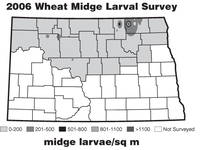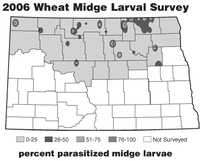Orange Blossom Wheat Midge Waiting in the Wings
(Click an image below to view a high-resolution image that can be downloaded)
A soil survey conducted last year detected increasing levels of overwintering wheat midge larvae for the upcoming 2007 season, according to Janet Knodel, North Dakota State University Extension Service entomologist.
“Wheat midge populations ranged from zero to 1,250 midge larvae per square meter, with most of the state having less than 200 midge larvae per square meter during 2006.” Knodel says.
However, two “hot” spots with more than 500 midge larvae per square meter have shown up in Cavalier and Towner counties in northeastern North Dakota. Fields with more than 1,200 midge larvae per square meter are considered high risk. At that point, some control tactic must be used to reduce midge populations or planting of a nonwheat host, such as canola or sunflowers, is recommended. There also are several pockets of lower numbers of 201 to 500 midge larvae per square meter in northern Ward County and north-central Mountrail County. Areas with more than 200 midge larvae per square meter should be scouted to determine if economic population levels exist.
“There are several reasons for the increasing populations of wheat midge in North Dakota,” Knodel says. “There is a correlation with fungicide spraying for wheat scab and the amount of insecticides sprayed for wheat insect pests because tank-mixing of fungicides and insecticides is popular to save application costs. Since the weather has been unfavorable for scab development during the past few years, less fungicides and insecticides have been applied.
“Also, the tiny, black parasitic wasp that helped control wheat midge populations has decreased by half from an average parasitism rate of 16 percent in 2005 to 8 percent in 2006. This wasp, Macroglenes penetrans, parasitizes the wheat midge larvae and eggs and will emerge the following spring and kill the wheat midge larvae.”
Parasitism ranged from 0 percent to 100 percent, with the higher rates occurring in areas where midge populations have been high the past few years.
“However, this year the majority of the state is below 25 percent parasitism, which is an alarming decline in parasitism from previous years.” Knodel says.
The wheat midge degree-day model developed by Canada has helped predict emergence and peak activity periods, as well as when field monitoring should take place. Using a base of 40 degrees Fahrenheit, 90 percent of female wheat midge has emerged by 1,600 degree days. Actual degree days are calculated and maps available for producers on the NDSU NDAWN Web site at http://ndawn.ndsu.nodak.edu/wheat-midge-form.html.
“Careful, regular monitoring of wheat and durum fields is good insurance if your crop is susceptible (heading to early-flowering) after wheat midge have emerged and are active,” Knodel says. “Scout fields after 9 p.m. if the temperature is above 59 degrees and the wind speed is less than 6 mph. Count the number of adult wheat midge present on four or five heads at several locations and then use an average per field.”
Economic thresholds are one midge per four to five wheat heads for hard red spring wheat and one midge per seven to eight heads for durum. At these levels of infestation, wheat yields will be reduced by 15 percent and lower the grade of harvested grains if the midge is not controlled.
Not every small fly in the crop will be a wheat midge. Wheat midge is a small, fragile, orange fly about 2 to 3 millimeters in size. Another small fly that is common in wheat fields is the lauxanid, which is larger (2.5 to 4 millimeters), more robust and yellowish brown. The wheat midge tends to flutter from plant to plant and rests with its head pointing skyward. The lauxanid flies and rests in a horizontal position with its head pointing toward the ground.
“A newer alternative to field scouting is using sex pheromone traps or yellow sticky traps to monitor for wheat midge in wheat fields,” Knodel says. Traps are placed next to the wheat head at the beginning of heading and collected in three to five days. Three sex pheromone traps ($7.20 a trap) per 160-acre wheat field or 10 yellow sticky traps (60 cents per trap) per field are recommended. The number of wheat midge per trap is counted and the average per trap calculated.
Action thresholds are nine wheat midges per sex pheromone trap and five to 20 wheat midges per yellow sticky trap. Sex pheromone traps are available through PheroTech International (http://pherotech.com/). Yellow sticky traps are available through Great Lakes IPM (http://greatlakesipm.com/) or PheroTech International. Specific trapping guidelines also are available through distributors.
The wheat midge survey is conducted by the NDSU Extension Service and supported by the North Dakota Wheat Commission.
NDSU Agriculture Communication
| Source: | Janet Knodel, (701) 231-7915, janet.knodel@ndsu.edu |
|---|---|
| Editor: | Rich Mattern, (701) 231-6136, richard.mattern@ndsu.edu |



